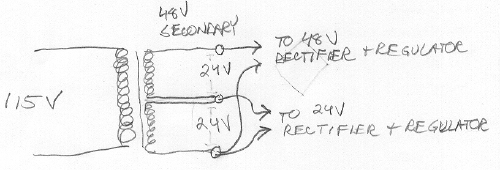Hi all,
There has been discussion about getting +24 volts and +48 volts from the same supply, and different kinds of voltage doubler circuits to provide the voltages. I was wondering if wiring a 24-0-24 transformer like this would eliminate the need for a voltage doubler, and if there are any particular advantages or disadvantages to doing it this way.

Thanks
There has been discussion about getting +24 volts and +48 volts from the same supply, and different kinds of voltage doubler circuits to provide the voltages. I was wondering if wiring a 24-0-24 transformer like this would eliminate the need for a voltage doubler, and if there are any particular advantages or disadvantages to doing it this way.

Thanks




